Related Research Articles

Formula Two, abbreviated to F2, also called Formula 2, is a type of open-wheel formula racing category first codified in 1948. It was replaced in 1985 by Formula 3000, but revived by the FIA from 2009–2012 in the form of the FIA Formula Two Championship. The name returned in 2017 when the former GP2 Series became known as the FIA Formula 2 Championship.

The BMW M3 is a high-performance version of the BMW 3 Series, developed by BMW's in-house motorsport division, BMW M GmbH. M3 models have been produced for every generation of 3 Series since the E30 M3 was introduced in 1986.

The BMW M6 is a high-performance version of the 6 Series marketed under the BMW M sub-brand from 1983–2018.

The BMW M1 is a mid-engined sports car produced by German automotive manufacturer BMW from 1978 to 1981.
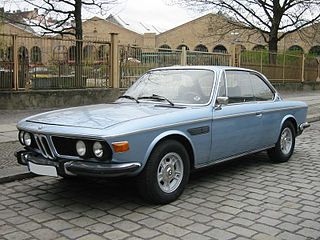
The BMW E9 is a range of coupés produced from 1968 to 1975. Initially released as the 2800 CS model, the E9 was based on the BMW 2000 C / 2000 CS four-cylinder coupés, which were enlarged to fit the BMW M30 six-cylinder engine. The E9 bodywork was built by Karmann.

Chevron Cars Ltd. is an English manufacturer of racing cars, founded by Derek Bennett in 1965. Following Bennett's death in 1978, the firm has remained active in various guises. The original company's designs and name continue to be used to build replacement parts and continuation models of earlier Chevrons. In 2000, Chevron Racing Cars Ltd., founded by Vin Malkie acquired the trade mark Chevron Racing Cars Ltd and in addition to the company's other activities has designed and built new grand tourer racing cars under the Chevron name, as well as other continuation models of earlier Chevrons.

Paul Morris Motorsport, also known as its business name of Nemo Racing, is an Australian motor racing team that competed in V8 Supercars between 2000 and 2012. The team also won the 1997 AMP Bathurst 1000 and four Australian Super Touring Championships. The team is based at the Norwell Motorplex in Norwell, Queensland and currently competes in the Super3 Series.
The 1977 World Sports Car Championship season was the 25th season of FIA World Sportscar Championship motor racing. It featured two separate World Championship series.
The 1969 World Sportscar Championship season was the 17th season of FIA World Sportscar Championship motor racing. It featured the 1969 International Championship for Makes, which was a series for FIA Group 6 Prototype Sports Cars, Group 4 Sports Cars and Group 3 Grand Touring Cars and the 1969 International Cup for GT Cars, which was restricted to Group 3 Grand Touring Cars. The season ran from 1 February 1969 to 10 August 1969 and comprised 10 races.
The 1976 World Sports Car Championship was a motor racing series open to Group 6 cars,. The championship was contested over a seven race series which ran from 4 April to 19 September and included a secondary award, the 1976 FIA Cup for Cars up to 2 Litres. 1976 was the 24th season of FIA World Sportscar Championship racing.

The Chevron B21 is a 2-liter Group 5 sports prototype race car, designed, developed and built by British manufacturer Chevron, in 1972. Over its racing career, spanning 13 years, it won a total of 23 races, scored 45 podium finishes, and clinched 11 pole positions. It was powered by a naturally-aspirated 2.0 L (120 cu in) Ford-Cosworth BDG, or BMW M12/7, four-cylinder engine, both making around 275 hp (205 kW). Only 28 cars were built.

The Chevron B23 is a Group 6 sports prototype race car, designed, developed and built by British manufacturer Chevron, in 1973. Over its racing career, spanning 12 years, it won a total of 12 races, scored 41 podium finishes, and clinched 2 pole positions. It was powered by a naturally-aspirated 3.0 L (180 cu in) Ford-Cosworth DFV Formula One engine, producing 398 hp (297 kW).
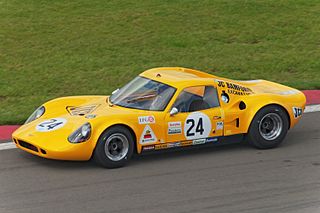
The Chevron B8 is a lightweight sports racing car, designed, developed and built by British manufacturer Chevron Cars, in 1968. It is homologated in the Prototype category of the International Automobile Federation.It won thirty-six races during her various engagements. Only 44 cars were built.
Colin Bond Racing was an Australian motor racing team that competed in the Australian Touring Car Championship between 1984 and 1993.
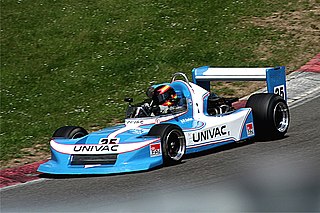
The March 782 was an open-wheel Formula 2 car, designed, developed and built by British manufacturer March Engineering in 1978. The 782 chassis was very competitive, and March dominated the season with their 782 chassis, and it was a clean-sweep; winning 11 out of the 12 races, and Bruno Giacomelli winning the championship, with 78 points. Marc Surer finished second-place in the championship as runner-up, with 48 points ; also driving a 782 chassis. It saw continued used through 1981, with Alberto Colombo winning at Hockenheim in 1980 with a two-year-old 782 chassis.

The Chevron B36 was a Group 6 prototype sports car, designed, developed, and built by British manufacturer Chevron Cars in 1976 and used in sports car racing until 1987. Over that time period, it won a total of 14 races, and achieved 43 podium finishes.

The Chevron B16 was a Group 4 sports prototype race car, designed, developed, and built in 1969 by the British racing car manufacturer Chevron Cars as a two-seater racing sports car for the makes world championship. Brian Redman won the very first outing, the 500 km (310 mi) race at the Nürburgring on September 7, 1969, at a time of 3:13:01.6 hours. The last victory with a Chevron B16 was achieved by Clemens Schickentanz on July 11, 1971, in the sports car race at the Norisring.
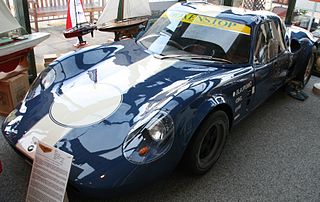
The Chevron B5 is a sports racing car, designed and developed by British manufacturer Chevron, and built by David Bridges, in 1967. Only one single car was constructed. It was powered by a naturally-aspirated 2.0 L (120 cu in) BRM V8 engine. Over its racing career, spanning 4 years, it won a total of 3 races, and scored 7 podium finishes.
The Chevron B4 was the second sports racing car to be developed and built by British manufacturer Chevron, in 1966. It was designed by British engineer, Derek Bennett. It was powered by a naturally-aspirated BMW M10 four-cylinder engine. Over its racing career, spanning two years, it only managed to score one class win, with its best race result being a 4th-place finish. Only one single model was built.
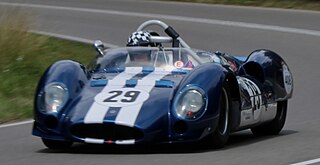
The Cooper T61 , also known as the Cooper T61 Monaco, or the Cooper Monaco T61, is a sports racing car, designed, developed and built by British manufacturer Cooper, in 1961. It is the successor and evolution of the T57. Its motor racing career spanned 6 years ; where it won a total of 16 races, achieved 23 podium finishes, and clinched 3 pole positions. It was powered by a number of different engines, including a Coventry Climax four-cylinder engine, a Maserati V8 engine, a Ford FE engine, and a Chevrolet small-block engine.
References
- ↑ "1967 CHEVRON B6 // Home Of Horsepower".
- ↑ "1967 Chevron B6 BMW Specifications". Ultimatecarpage.com.
- ↑ "Chevron B6/B8". Motor Sport Magazine.
- ↑ "Chevron B6 BMW, 1967 [Auta5P ID:2893 EN]". auta5p.eu.
- ↑ "Chevron B6 BMW Specs :: autoviva.com". www.autoviva.com.
- ↑ "Chevron B6" . Retrieved 24 June 2022.
- ↑ "Chevron B6". www.rmd.be.
- ↑ Brown, Allen. "Chevron « Marques « OldRacingCars.com". OldRacingCars.com.